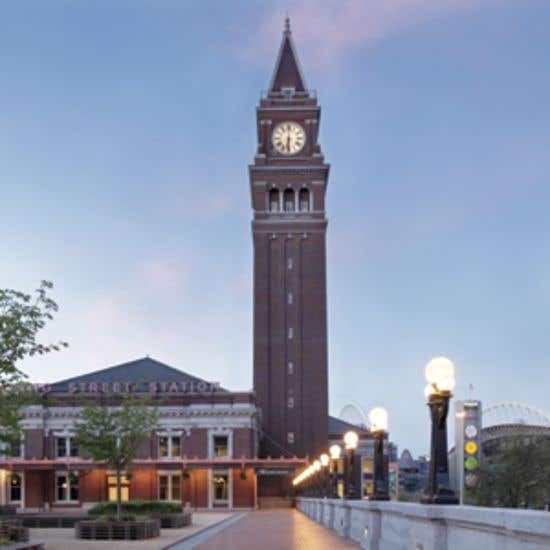
Public Buildings
Restoration of the King Street Station in Seattle
PROJECT Restoration of King Street Station, Seattle, WA
OWNER Department of Transportation, City of Seattle
ARCHITECT ZGF Architects, Seattle, WA; Tim Williams, associate partner, project manager; Dave Grant, landscape architect
HISTORIC CONSULTANT Artifacts Architectural Consulting, Inc., Tacoma, WA; Michael S. Sullivan, principal
GENERAL CONTRACTOR Sellen Construction, Seattle, WA; Ron Lamarche, superintendent; Garrett Condel, project manager
LEED Green Building Services, Inc., Portland, OR; Ralph DiNola, principal in charge; Beth Shuck, planner; expected to receive LEED Platinum certification


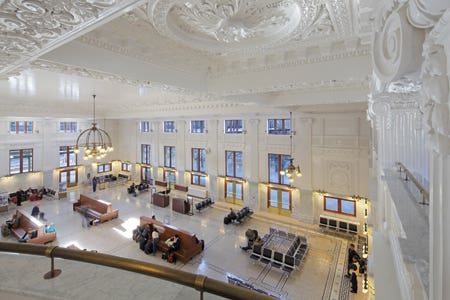
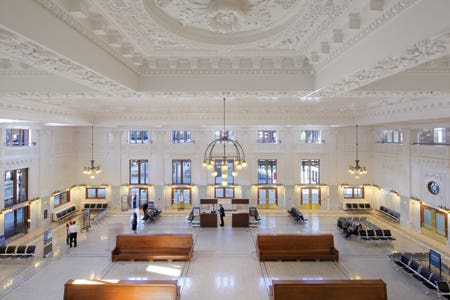
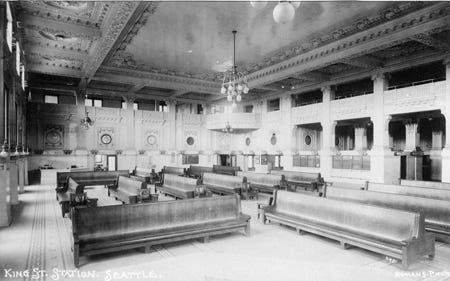
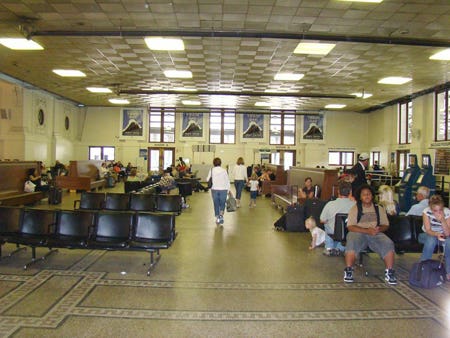
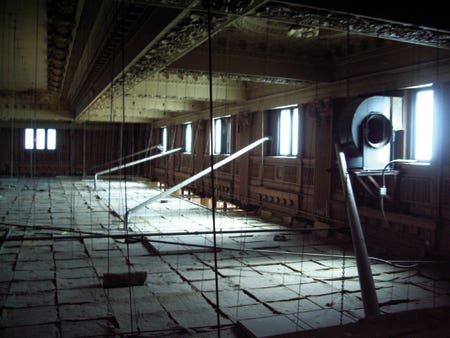
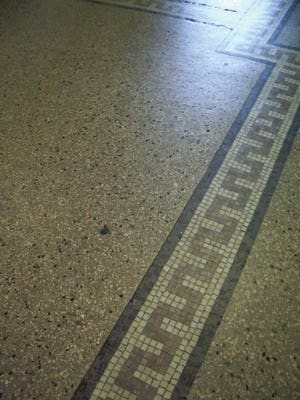
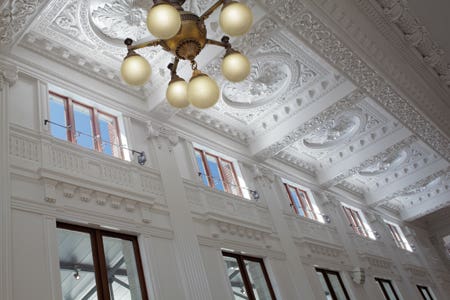
On March 5, 2008, Seattle, WA, made one of the most important investments in its history – and it only cost $10. The city purchased King Street Station, a national, state and city landmark from Burlington Northern Railroad (now BNSF). Initially the price had been set at $1, but the city found it couldn't write a check for that amount, so it offered $10. In spite of the recession that hit the country in 2008, Seattle moved forward with plans to restore the historic station and was able to amass $50 million for the project.
The 62,400-sq.ft., three-story building (plus another 6,400 sq.ft. for the 242-ft.-tall clock tower) holds a special place in the hearts of the citizens of Seattle. Completed in 1906 and built in a style sometimes called "Railroad Italianate," it was designed by Reed and Stem, the firm that worked with Warren and Wetmore on New York City's Grand Central Station. The brick building with a granite base features a tower modeled after the Campanile di San Marco in Venice.
Like many other historic buildings, King Street Station suffered a mid-century "modernization," starting in 1949 with the installation of an exterior escalator, and going through the mid 60s. All of the ornate vertical plaster was stripped from the waiting room walls up to the level of the new dropped ceiling that was 10 ft. lower than the original. This new ceiling hid the original balcony and second level arcade and punctured holes in the original plaster ceiling. This restoration also stripped the station of its historic lighting, reduced the grand staircase connecting the King Street and Jackson Street levels.
"It is one of three transportation hubs in downtown Seattle," says Trevina Wang, King Street Station Program Manager, Seattle Department of Transportation. "It was challenging because it is on the National Register of Historic Landmarks and it is also a city and state landmark. So any alteration had to be reviewed at the federal and local levels. Our goal was to preserve as much of the historic elements as possible and incorporate sustainable features as appropriate without obscuring the historic features. Some of the sustainable elements were hidden by the historic façade."
One of the challenges was keeping the station open and operating during all of the work. "It is a working train station," says Wang. "It has been open since May, 1906 and we kept it open the whole time throughout construction."
The goal of a LEED Platinum rating was stated from the beginning. "The city was clearly interested in not just meeting city requirements," says Ralph DiNola, principal in charge, Green Building Services. "They knew this would be a real flagship property. We discussed the potential of LEED platinum, and then we held an eco-charrette to determine what sustainability measures would be possible for the project. From the beginning, all of the team members were in alignment in achieving the rating."
The first phase, completed in 2009, involved the roof and the clocks on the clock tower. New green-glazed terra-cotta tile roofing manufactured by the same company that had supplied the original tile, Ludowici Roof Tile, New Lexington, OH, was used for the roof. The four clocks on the tower were repaired by two gentlemen from the National Association of Clock & Watch Collectors, Paul Bellamy and Norm Nelson. "This was challenging because they are both in their 70s and they had to walk up and down all of those stairs every day," says Wang. "We replaced the roof because it was leaking," she adds, "then we hired the design team."
ZGF Architects and Sellen Construction were brought in after the first phase and tasked with upgrading all systems – seismic, electrical, mechanical, plumbing and fire protection – in the entire building and the tower, and with repairing and re-creating the elaborate finishes in the public spaces, especially the main waiting room. "Once the design was completed, we realized that we had to proceed in phases because of limited funding," says Wang.
Completed in 2011, phase 2 involved the installation of a new geothermal system that supplies all of the heating and cooling to the building, contributing significantly to the building's LEED Platinum certification. Also contributing to this certification is the fact that natural ventilation was restored to the waiting room.
Wang points out that the 67 geowells connected to the ground-source heat pump (supplied and installed by Geo Loop Tec in Seattle) are hidden by the foundation slab of the building.
A glass canopy was installed on the north side to let in more light. "Originally the building had glass canopies on all four sides, but they had been replaced with metal. We went back to glass for the north side to maximize natural light," she explains. In addition, solar panels were installed on the canopy on the south side of the building. "They are not prominent and they contribute to the energy efficiency of the building because they get a lot of sunlight," Wang notes.
The building is on an 18-ft. grade with Amtrak located on the first floor at the King Street level while the second floor exits on to Jackson Street. The Jackson Street Plaza is the roof of the first floor. It is now a plaza, a public gathering space.
"In addition to the new systems, our renovation removed all of the 1960s additions," explains Tim Williams, associate partner, project manager, ZGF Architects. "This included removing the exterior escalator and the dropped ceiling in the main waiting room, restoring windows, replacing historic light fixtures and re-creating the ornate plaster work in the main waiting room."
A huge portion of the project was adding steel to the structure to protect it from seismic events. "We are located in a zone 4 earthquake zone," Williams points out. "Working with KPFF Consulting Engineers, Inc. and the structural engineer ARUP, we designed a system that preserves the entire original building. People looking at the building today would have no idea so much steel was added."
In fact, 67 piles weighing 96 tons were installed inside and outside of the station. They were tied into rebar cages inside the new foundation slabs. And 1,345 tons of steel were installed on the interior, including new columns inserted into the perimeter walls on both sides of the brick-covered historic columns, new steel wall plating, box columns to reinforce the existing structural interior columns and new beams and diaphragm bracing. In addition, new shear walls were added in the main waiting room and steel floor plates were added on levels two and three. The entire clock tower was cross braced and new columns were added on all corners.
While people passing through the station probably won't notice all of the new steel, they are sure to notice the new ornate plasterwork in the grand 8,000-sq.ft. main waiting room with its 34-ft. ceilings. EverGreene Architectural Arts of NYC set up shop in the station and re-created and repaired all of the historic molding in the main waiting room. The work included re-creating all of the vertical plasterwork above the 8-ft. marble wainscoting and repairing and replacing the original ceiling. In many cases, new molds had to be created.
Williams notes that high-gloss paint was used on the plasterwork in the main waiting room. "Although it's not something we would commonly use today, historic black-and-white photographs of the space and research into the original color of the paint, led us to what you see in the main waiting room today, mirroring the original historic finish as precisely as possible," he says.
To repair the marble wainscot in the main waiting room, ZGF found Carrara marble that was an acceptable match. The original was thought to have come from Alaska, but that was no longer available. A mosaic band within the marble wainscot was restored using glass tile found in Murano, Italy. Mixed-Up Mosaics of NYC prepared the mosaics to match the 1906 pattern.
The windows were repaired, or replaced in some cases, by Bear Wood Windows, of Tacoma, WA. "All of the sashes and frames were old-growth Douglas fir and they were in fairly good shape, but the windows had to be restored," Williams notes. "All of the original windows were restored," says Wang. "We only replaced the aluminum replacement windows. The new windows use thermal pane glass but they have the same look as the original windows."
The historic light fixtures, both interior and exterior, were re-created by Eleek, Inc., Portland, OR. "They are historic in appearance, but they use contemporary LED light sources," Williams points out. "The LED fixtures contribute to energy conservation," Wang adds.
One area that didn't require much restoration was the original terrazzo flooring. "It was largely intact," Williams notes, "requiring only a rebuffing."
On the exterior, the team was able to find salvaged materials for two areas. For one, the glass tile on the pyramid of the tower had originally been manufactured by the same company that provided the roof tile, Ludowici. "The original 100-year-old glass tile contains manganese, so it turns purple as it oxidizes," Williams explains. "An exact match to this 100-year-old glass couldn't be found, and that shape is no longer available. Just as the city was deciding what to do, someone called Ludowici, and said that they had a large quantity of old glass tile in storage and wanted to know if the company was interested in it," he says. "So the city of Seattle was able to acquire the tiles from the original manufacturer. They also happened to be 100 years old, so they had oxidized to the same color as the tile on the tower. The stars were aligned so that the station was able to get the tiles to match close to perfectly."
Another area where the stars aligned to provide salvaged material for the exterior was with the granite base. Portions of this granite had been lost when the escalator was added in the mid 60s. "We needed to replace the granite and the original quarry was no longer open," Williams says. "We were struggling to find a stone that would match. During the excavation, we discovered that the foundation stone was an exact match, so we were able to harvest it from the site. It was taken to the shop and cut to fit."
What's the next phase for the historic station? Wang says that the city is soliciting proposals to develop the upper two floors. "It is vacant space now," she notes. "It could be used as office, commercial or retail spaces. These areas don't have elaborate finishes."
Williams notes that what was once called the women's waiting room has not been renovated, and would be an opportunity for a restaurant in the future. The restored King Street Station is near the existing light rail and a new street car system is scheduled to be added. In addition, developers are planning to add 900 units of housing and mixed-use development nearby. "The restoration of the station has been somewhat of a catalyst for the neighborhood, giving developers the confidence that this is a good area for investment," says Williams. The nearby development is being heralded as the largest transit-oriented development on the West Coast.
"This is a poster child for what often happens to historic buildings," says DiNola. "In the 60s and 70s, they destroyed the aesthetics and historic fabric. Our sensibility about those energy-efficient alterations has changed a lot." He adds that historic buildings lend themselves to achieving high LEED ratings because they were designed to be inherently energy efficient, with daylighting and passive strategies. "If you look at the historic photo, you will notice that the lights are not on."
The King Street Station also received LEED points for its location in a dense urban area, and obviously, for being near public transportation, DiNola adds. "Ten years ago, it was a rundown place." says Williams. "Now it is once again a place of tremendous pride," he states. "People arriving in Seattle can feel the same sense of arrival that they would have felt years ago. And the target of LEED Platinum certification contributes to the city's reputation as one of the country's greenest cities." ZGF is now moving on to another historic train station restoration, this one in Sacramento, CA.








